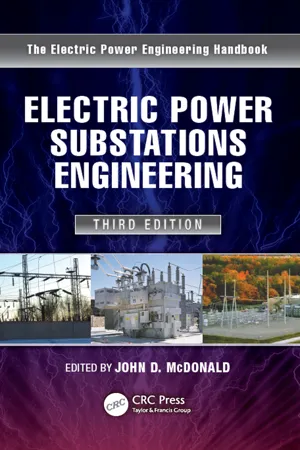
- 536 pages
- English
- ePUB (mobile friendly)
- Available on iOS & Android
Electric Power Substations Engineering
About this book
The use of electric power substations in generation, transmission, and distribution remains one of the most challenging and exciting areas of electric power engineering. Recent technological developments have had a tremendous impact on all aspects of substation design and operation. With 80% of its chapters completely revised and two brand-new chapters on energy storage and Smart Grids, Electric Power Substations Engineering, Third Edition provides an extensive updated overview of substations, serving as a reference and guide for both industry and academia. Contributors have written each chapter with detailed design information for electric power engineering professionals and other engineering professionals (e.g., mechanical, civil) who want an overview or specific information on this challenging and important area.
This book:
- Emphasizes the practical application of the technology
- Includes extensive use of graphics and photographs to visually convey the book's concepts
- Provides applicable IEEE industry standards in each chapter
- Is written by industry experts who have an average of 25 to 30 years of industry experience
- Presents a new chapter addressing the key role of the substation in Smart Grids
Editor John McDonald and this very impressive group of contributors cover all aspects of substations, from the initial concept through design, automation, and operation. The book's chapters—which delve into physical and cyber-security, commissioning, and energy storage—are written as tutorials and provide references for further reading and study.
As with the other volumes in the Electric Power Engineering Handbook series, this book supplies a high level of detail and, more importantly, a tutorial style of writing and use of photographs and graphics to help the reader understand the material. Several chapter authors are members of the IEEE Power & Energy Society (PES) Substations Committee and are the actual experts who are developing the standards that govern all aspects of substations. As a result, this book contains the most recent technological developments in industry practice and standards.
Watch John D. McDonald talk about his book
A volume in the Electric Power Engineering Handbook, Third Edition.
Other volumes in the set:
- K12642 Electric Power Generation, Transmission, and Distribution, Third Edition (ISBN: 9781439856284)
- K12648 Power Systems, Third Edition (ISBN: 9781439856338)
- K13917 Power System Stability and Control, Third Edition (ISBN: 9781439883204)
- K12643 Electric Power Transformer Engineering, Third Edition (ISBN: 9781439856291)
Frequently asked questions
- Essential is ideal for learners and professionals who enjoy exploring a wide range of subjects. Access the Essential Library with 800,000+ trusted titles and best-sellers across business, personal growth, and the humanities. Includes unlimited reading time and Standard Read Aloud voice.
- Complete: Perfect for advanced learners and researchers needing full, unrestricted access. Unlock 1.4M+ books across hundreds of subjects, including academic and specialized titles. The Complete Plan also includes advanced features like Premium Read Aloud and Research Assistant.
Please note we cannot support devices running on iOS 13 and Android 7 or earlier. Learn more about using the app.
Information
Table of contents
- Cover
- Half Title
- Title Page
- Copyright Page
- Table of Contents
- Preface
- Editor
- Contributors
- 1 How a Substation Happens
- 2 Gas-Insulated Substations
- 3 Air-Insulated Substations: Bus/Switching Configurations
- 4 High-Voltage Switching Equipment
- 5 High-Voltage Power Electronic Substations
- 6 Interface between Automation and the Substation
- 7 Substation Integration and Automation
- 8 Oil Containment
- 9 Community Considerations
- 10 Animal Deterrents/Security
- 11 Substation Grounding
- 12 Direct Lightning Stroke Shielding of Substations
- 13 Seismic Considerations
- 14 Substation Fire Protection
- 15 Substation Communications
- 16 Physical Security of Substations
- 17 Cyber Security of Substation Control and Diagnostic Systems
- 18 Gas-Insulated Transmission Line
- 19 Substation Asset Management
- 20 Station Commissioning and Project Closeout
- 21 Energy Storage
- 22 Role of Substations in Smart Grids
- Index